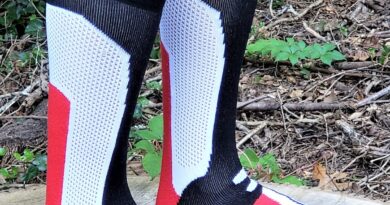Living with Aerostich’s Transit 3 suit through all four seasons
Last year I introduced Aerostich’s remarkable Transit 3 suit, with its unique waterproof leather construction. Interesting details of the suit’s design are too numerous to recount here, but you can read my First Look article to get a full inventory. See also my early commentary on the suit in “Not What You Think.” When I wrote those articles, I’d just begun wearing the Transit 3 and could only relay my first impressions, which included appreciation for the suit’s comfort, admiration of its craftsmanship, and hopeful excitement about its day-to-day functionality. If you only read what follows here, you’ll have a skewed perspective because I’m just going to comment on a few aspects that weren’t immediately apparent or verifiable. Overall, the Transit 3 has lived up to or exceeded the high expectations generated by my initial examination.
 I’ve now lived with this artfully crafted garment through all four seasons in widely varying weather conditions, although my sampled range is characteristic of the southeastern U.S. and hasn’t included the colder or more arid environs elsewhere. Another caveat has to do with fitment. Whereas I found the suit in my usual size far too loose for my taste in leather kit, I now recognize the roominess I eschewed for a snugger feel (I dropped down a size) would have allowed more comfort across a broader span of temperatures. I don’t regret this sacrifice because I still prefer a closer fit for the majority of my (virtually year-round) riding season, but those wishing to extend the temp-related parameters described below can probably do so by opting for their usual size instead of going smaller (I strongly recommend talking with Aerostich staff to confirm sizing). The climatic comfort limitations I experienced had more to do with my fitment choice than inadequacies in the suit’s design or construction. Also potentially of note, most of my riding in the Transit 3 was on a minimally-faired bike, an R 1250 RS with the windscreen in its lowest position. More or less wind exposure may impact temp considerations, too. Last in this list of disclosures, I’m not a high-mileage guy, and I rotate through lots of different riding gear, so my Transit 3 has only covered a few thousand miles so far.
I’ve now lived with this artfully crafted garment through all four seasons in widely varying weather conditions, although my sampled range is characteristic of the southeastern U.S. and hasn’t included the colder or more arid environs elsewhere. Another caveat has to do with fitment. Whereas I found the suit in my usual size far too loose for my taste in leather kit, I now recognize the roominess I eschewed for a snugger feel (I dropped down a size) would have allowed more comfort across a broader span of temperatures. I don’t regret this sacrifice because I still prefer a closer fit for the majority of my (virtually year-round) riding season, but those wishing to extend the temp-related parameters described below can probably do so by opting for their usual size instead of going smaller (I strongly recommend talking with Aerostich staff to confirm sizing). The climatic comfort limitations I experienced had more to do with my fitment choice than inadequacies in the suit’s design or construction. Also potentially of note, most of my riding in the Transit 3 was on a minimally-faired bike, an R 1250 RS with the windscreen in its lowest position. More or less wind exposure may impact temp considerations, too. Last in this list of disclosures, I’m not a high-mileage guy, and I rotate through lots of different riding gear, so my Transit 3 has only covered a few thousand miles so far.
 The first question must be, “Is the Corium+ leather really waterproof?” The answer is, “Yes!” Although I haven’t ridden through a day-long deluge in the Transit 3, I have endured lengthy periods of moderate rain without water penetrating (or saturating) the latex-infused, one-way membrane-backed leather. The material does absorb a bit of moisture superficially, but this bears no resemblance to the way regular leather soaks up water and becomes a heavy, sodden mess. I valued the Mandarin collar’s close-fitting (yet soft and pliable) contour, which did a nice job of sealing out rain without feeling tight.
The first question must be, “Is the Corium+ leather really waterproof?” The answer is, “Yes!” Although I haven’t ridden through a day-long deluge in the Transit 3, I have endured lengthy periods of moderate rain without water penetrating (or saturating) the latex-infused, one-way membrane-backed leather. The material does absorb a bit of moisture superficially, but this bears no resemblance to the way regular leather soaks up water and becomes a heavy, sodden mess. I valued the Mandarin collar’s close-fitting (yet soft and pliable) contour, which did a nice job of sealing out rain without feeling tight.
Another noteworthy feature of the Corium+ is its apparent durability. I haven’t crashed in my Transit 3, but I’ve been impressed by its resistance to any visible scuffing from casual contact with abrasive surfaces, such as sitting/leaning on rough curbs and pavement. Nor does it show any signs of wear and tear from getting wet or being exposed to UV radiation, despite the fact I have yet to clean or condition the leather beyond using a damp cloth to wipe off splattered bugs. This suit has remained luxuriously smooth and supple, and has offered a very comfortable – and comforting – counterpoint to my closetful of nylon-based textile gear. Leather’s additional weight and mildly stiffer texture provide the Transit 3 wearer with a reassuringly sturdier, more secure feel (especially with snug fitment) than what one gets from typical synthetics. If it’s been a while since you donned cowhide instead of Cordura, you may have forgotten the ways leather feels better.
 One drawback of leather, however, is its reluctance to fold at the sleeve cuffs. There, its bulk and stiffness—along with that of the waterproof zipper and its gusset—can create awkward interface with some glove gauntlets, an issue that has persisted despite my use of Aerostich’s recommendation to facilitate break-in by leaving the cuffs in a clamp or vice for a while with a crease in the desired location; doing this reduces but doesn’t eliminate the quirk. Cinching down the cuffs to accommodate slim gauntlets on the outside can create an unwelcome lumpy impingement at the wrist. Conversely, the cuffs are restrictive enough, even with their gussets unzipped, to resist the insertion of longer or thicker gauntlets inside the sleeve. Gloves with abbreviated or expandable gauntlets work just fine.
One drawback of leather, however, is its reluctance to fold at the sleeve cuffs. There, its bulk and stiffness—along with that of the waterproof zipper and its gusset—can create awkward interface with some glove gauntlets, an issue that has persisted despite my use of Aerostich’s recommendation to facilitate break-in by leaving the cuffs in a clamp or vice for a while with a crease in the desired location; doing this reduces but doesn’t eliminate the quirk. Cinching down the cuffs to accommodate slim gauntlets on the outside can create an unwelcome lumpy impingement at the wrist. Conversely, the cuffs are restrictive enough, even with their gussets unzipped, to resist the insertion of longer or thicker gauntlets inside the sleeve. Gloves with abbreviated or expandable gauntlets work just fine.
A second downside, related partly to the Corium+ and partly to the Transit 3’s design, is limited ventilation for hot weather riding. As mentioned in my initial review, the visible perforations in the leather are for water vapor egress after it has passed through the one-way membrane laminated to the leather’s interior. Those holes do not admit airflow into the suit’s interior, as that same membrane is windproof (an asset in cold weather). Note that all gear with this type of membrane suffers from the same trade-off: the microscopic holes that allow water vapor to exit while blocking liquid water’s entrance also preclude cooling airflow. The only way to compensate for this is with waterproof zipper-equipped vents. The Transit 3 has such vents under each arm and along the upper back (beneath a reflective flap that folds out of the way). The gusseted cuffs can also be left unzipped to funnel some breeze into the sleeves, as long as airflow there isn’t blocked by your gloves.

I found ventilation adequate into the upper 80s, but wanted more once the temperature exceeded 90 degrees—especially in the dreadfully high humidity of a southeastern summer. I tried my usual solution of wearing LD Comfort’s excellent evaporative cooling shirt under the Transit 3 jacket, but achieved little relief (although a wet neck wrap, like one of Aerostich’s silk scarves, helped considerably). My decision to opt for a snug-fitting suit had the unintended consequence of leaving too little room for airflow through the jacket’s interior, given the presence of only three smallish vents. Likewise, I can’t wear thick insulation under my Transit 3 on very cold rides. A couple layers of Merino wool or high-tech synthetic long underwear, along with a warming neck wrap (those silk scarves serve this purpose, too) allowed comfortable riding down to 50 degrees. Adding any more under the suit felt too tight and restrictive. I’m content with the resulting 40-degree range, as I have other gear to wear below 50 and above 90; those who want extended versatility should choose a looser-fitting Transit 3.

One final caution: Although Aerostich is famously generous with cargo capacity, the Transit 3 does not feature the brand’s usual multitude of voluminous pockets. What pockets exist are relatively small and/or tight. This hasn’t provoked any complaints from me, as I don’t load up my riding suits with lots of stuff and prefer to keep bulky items like my phone, wallet and snack bars in my tank bag. However, when leaving the bike (e.g., to enter a store or restaurant), I carry my valuables with me. The suit’s handwarmer jacket pockets can hold my wallet on one side and my phone on the other while I’m upright, but most stored items press against my torso in the riding position (also true if I use the interior lining pockets). The high exterior chest pocket is tough to access, but the right forearm pocket is handy for earplugs and loose cash/cards. Further down, the pants pockets, while deep, are tight across their horizontal zippered openings, resisting ingress. There are no pass-through zippers (as found on Aerostich’s Roadcrafter models) for accessing pockets in pants worn underneath the suit, nor are there any hip or thigh pockets. Perhaps slash openings would work better. I might attribute these pockets’ tightness to my choice of a tailored fit, except for the fact anything larger would have been prohibitively loose at the waist; even the size I have bunches up a tad there under my belt. Your proportions, and associated experience of these pockets, may vary.
 If you don’t require extensive storage and ventilation, and you have gloves with gauntlets that play well with the Transit 3’s sleeve cuffs, you’ll enjoy all-day comfort and a great sense of safety in this one-of-a-kind outfit. If you’re okay with having your cowhide fit loosely (instead of conjuring fond memories of your old road racing leathers), you’ll also be able to ride in truly cold and seriously hot weather, with no worries about encountering rain. And if you opt for the hi-viz yellow jacket rather than its black counterpart, you’ll get additional conspicuity with the rest of this gear’s long list of well-engineered features and superlative workmanship. (How many riders own hi-viz, waterproof leather?! It really is quite special.) Like most costs over the past year, admission to the elite Transit 3 club has increased, currently $1,187 for the jacket and $1,067 for the pants, with the total discounted $100 if both are purchased together. Top-shelf gear doesn’t come cheap. Again, make sure to read one of those introductory articles to understand the justifications for such pricing.
If you don’t require extensive storage and ventilation, and you have gloves with gauntlets that play well with the Transit 3’s sleeve cuffs, you’ll enjoy all-day comfort and a great sense of safety in this one-of-a-kind outfit. If you’re okay with having your cowhide fit loosely (instead of conjuring fond memories of your old road racing leathers), you’ll also be able to ride in truly cold and seriously hot weather, with no worries about encountering rain. And if you opt for the hi-viz yellow jacket rather than its black counterpart, you’ll get additional conspicuity with the rest of this gear’s long list of well-engineered features and superlative workmanship. (How many riders own hi-viz, waterproof leather?! It really is quite special.) Like most costs over the past year, admission to the elite Transit 3 club has increased, currently $1,187 for the jacket and $1,067 for the pants, with the total discounted $100 if both are purchased together. Top-shelf gear doesn’t come cheap. Again, make sure to read one of those introductory articles to understand the justifications for such pricing.
Most sizes of the Transit 3 are on hand at Aerostich, but due to supply chain complexity (they’re made in Asia with sub-components from many countries), backordered sizes can take months to restock. All the more reason for interested riders to check availability sooner rather than later.



